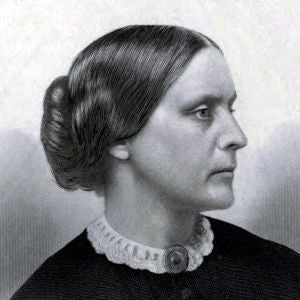Written by Sara Rising
[Photo Credit: Biography.com]
What better time and place to celebrate women’s rights than March in Rochester?! This month ‘Weird History Wednesday’ uses its nomenclature to more broadly mean ‘awesome’ as we explore the life and times of one of history’s most influential women and Rochesterians, Susan B. Anthony.
Born February 15, 1820 in Adams, Massachusetts, Susan B. Anthony grew up in a Quaker family. She went on to work as a teacher before becoming a leading figure in the abolitionist and women's voting rights movement. She partnered with Elizabeth Cady Stanton and would eventually lead the National American Woman Suffrage Association.
 [Photo Credit: Sara Rising]
[Photo Credit: Sara Rising]
 [Photo Credit: Sara Rising]
[Photo Credit: Sara Rising]
Upon moving to Rochester in 1845, the Anthony family became active in the antislavery movement. Antislavery Quakers met at their farm weekly, where they often were joined by Frederick Douglass – another prominent Rochesterian. During this time, Anthony began working as a teacher at the Canajoharie Academy. She quickly became involved in the New York teacher’s union when she discovered her male counterparts were making a monthly salary of $10.00, four times the amount female teachers earned at $2.50.
Several years later, in 1851, Anthony met fellow suffragette, Cady Stanton. They were both involved in the Temperance Movement, which aimed at prohibiting the sale of alcohol and encouraged women to seek legal solutions to protect their families from the poverty and violence caused by their husbands’ alcohol abuse.
It was during this time that Anthony became inspired to fight for women's suffrage. Anthony was denied a chance to speak at a temperance convention because she was a woman. She became convinced that women would only be able to influence public policy if they had the right to vote.
Before long, Anthony and Stanton formed the New York State Woman's Rights Committee and began circulating petitions, speaking at meetings and lobbying the state legislature to allow women not only the right to vote, but also the right to own property. The two also founded the American Equal Rights Association, and in 1868 became editors of its newspaper, The Revolution, published right here in Rochester. Underneath its title, the newspaper proudly displayed their motto, “Men, their rights, and nothing more; women, their rights, and nothing less.”
 [Photo Credit: Sara Rising]
[Photo Credit: Sara Rising]
In 1872, Anthony was arrested in Rochester for voting in the presidential election. Anthony refused to pay her streetcar fare to the police station, stating that she was "traveling under protest at the government's expense." She was arraigned along with fellow suffragettes and the election inspectors who had allowed the women into Rochester Common Council chambers. At her trial in Canandaigua in 1873, the judge instructed the jury to find her guilty without deliberations. He imposed a $100 fine, however did not imprison her when she refused to pay, therefore denying Anthony the option to appeal.
 [Photo Credit: Sara Rising]
[Photo Credit: Sara Rising]
Appalled at the injustice, she embarked on a speaking tour in, during which she delivered this famous line:
"It was we, the people; not we, the white male citizens; nor yet we, the male citizens; but we, the whole people, who formed the Union. And we formed it, not to give the blessings of liberty, but to secure them; not to the half of ourselves and the half of our posterity, but to the whole people — women as well as men."
Despite her legal trouble, Anthony persevered in her fight to amend the constitution to extend the right of suffrage to women. In 1877, she gathered petitions from 26 states, and over 10,000 signatures, only to be denied by Congress. She continued to appear before congress every year from 1869 to 1906. Between 1881 and 1885 Anthony, Stanton, Ida Husted Harper and Matilda Joslin Gage collaborated on and published the History of Woman Suffrage. The last volume, edited by Anthony and Ida Husted Harper, was published in 1902.
Even in her later years, Anthony persisted. In 1905, she met with President Theodore Roosevelt to petition for an amendment to the constitution. She died the following year at the age of 86 at her home in Rochester. According to her obituary in The New York Times, shortly before her death, Anthony told friend Anna Shaw, "To think I have had more than 60 years of hard struggle for a little liberty, and then to die without it seems so cruel."
 [Photo Credit: Sara Rising]
[Photo Credit: Sara Rising]
As we all (hopefully) know, it wouldn’t be until 1920 that the 19th Amendment to the Constitution granted women the right to vote. Treasury Department put Anthony's portrait on dollar coins in 1979 in recognition of her unwavering commitment. The series was halted due to poor public reception, in part because the coin was easily confused with the similarly-sized quarter.
Fast forward to 2020 and we may be seeing her face don the new $10 bill. Since the unveiling will coincide with the 100th anniversary of the 19th Amendment, what better way to celebrate such an incredible and necessary force for change in our history?
Fun Fact: In 1900 Anthony advocated for equal education and cashed in her own insurance policy to make sure women could be admitted to the University of Rochester for the first time.
Sources:
Susan B. Anthony House. Her Story: Biography.
PBS. Biography: Susan B. Anthony and Elizabeth Cady Stanton.

![[Photo Credit: Biography.com]](http://cdn.shopify.com/s/files/1/0208/0322/files/SBA_Portrait_large.jpg?16319501150578476448)